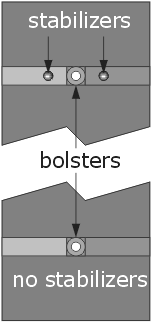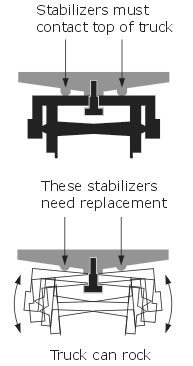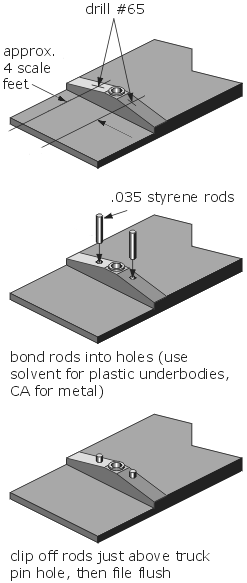Eliminate Car Wobble!
a.k.a. "For improved realism: wipe out freight car wobble"
Enhancing N Scale Rolling Stock Performance
Your trackwork is impeccable, the engine runs like a watch, and the scenery is true to life. It's a perfectly convincing scene. And then here comes the train—wobbling down the track like a cheap toy. Darn!
Nothing destroys the illusion of realism on a layout quite as quickly and thoroughly as a string of wiggly, jiggly cars. Why do they do that? And what can you do to fix it?
The Cause
Over the years I've heard quite a variety of explanations for N scale car wobble. High center of gravity is a popular one. Insufficient car weight is another. Excessive car height to clear deep flanges has also been cited. Poor trackwork is sometimes blamed. Even the scale itself has been derided, usually by larger-scale enthusiasts prone to fits of "scale prejudice."
While a high center of gravity might contribute to car wobble by exaggerating it somewhat, it's not the cause. Car weight principally affects tracking ability. Incorrect car height affects appearance, not performance (not many cars are incorrect, anyway). And if trackwork was bad enough to make cars wobble continuously, it's unlikely they could stay on the rails. Finally, cars in larger scales wobble, too, and for the same reasons.
In reality there are only two sources of chronic model car wobble: wheels and bolsters. If the wheels aren't in perfect shape, or if the bolsters aren't up to par, then the car will wobble. Fortunately, it's relatively simple to correct both problems.
If the car jiggles or gallops fairly rapidly, wheels are the first things to check. If the car tends to flop or sway from side to side more slowly and irregularly, then the bolsters are probably to blame. But it can also be a combination effect, so once a problem car reaches the workbench, you may as well check everything.
The Cure, Part 1: Wheels
Holding the truck steady, flick each wheelset with your finger. They should spin freely; if not, they need to be replaced anyway. As the wheels turn, examine them carefully for concentricity. Even the tiniest irregularity will lead to car wobble. A better way to check wheels is to remove the trucks from the car and roll each one quickly along a test track between your fingers—if you feel the truck vibrate, the wheels are bad.
Metal wheelsets will have a plastic insulating collar on one side, and this is often the culprit. Solid plastic wheelsets are molded in one piece, and while the wheels may be concentric about the axle, the axle may be warped, which will throw both wheels off. Plastic wheelsets are also molded in different ways, and some cheaper ones aren't even round.
There's only one way to correct problem wheels: replace them. Micro-Trains replacement wheelsets are consistently concentric. Higher-quality metal replacements, such as those from Fox Valley Models, will be reliably round. Also note that overall performance on the layout can be improved if you use as few different wheelset types as possible—since there are no true standards for wheel profiles, variations can play havoc with turnouts, crossings and other complex trackwork.
When replacing wheelsets, note that axles can be different lengths, according to the truck brand. Replacements that are too long will bind or won't fit at all, and ones that are too short will cause poor tracking and might even drop out of the truck (usually in a tunnel at the back of the layout), so be sure to get the appropriate type. Also keep an eye out for warped trucks, which may make the wheelsets too loose or too tight, or may not let them rest squarely on the rails. The ideal solution for wheelset and/or truck problems is to replace the entire truck.
You may find that even the very best wheelsets mysteriously start to wobble after a while. This is most often due to dirt build-up on the wheel treads. If you get into the habit of periodically cleaning wheels, this problem can be prevented. A simple wheel cleaner is a length of flex track with a piece of paper towel laid across the rails. Apply a safe plastic cleaning solvent (rubbing alcohol is good) to half of the towel and roll the car back and forth across the wet part, then repeat on the dry half.
The Cure, Part 2: Bolsters
You may have just installed brand new trucks only to discover that some of your cars still wobble. Don't despair. Be aware that bolsters do more than simply provide mounting points for trucks; they're also responsible for the car's stability. Various problems can crop up in the bolsters of various cars, so be prepared to perform one or more of the following corrective measures.

The first thing to do is look for the proper bolster configuration, as shown in the figure above. The bolster on one end should have a pair of stabilizers—bumps, ridges or pins that rest on the truck frame to keep the car from leaning or tipping. The other bolster should have none, so that the car can track reliably. It's better to have them on both ends than neither, but if a car having two sets of stabilizers exhibits any tracking problems, remove them from one end.

Note that the stabilizers must be in constant contact with the truck frame in order to function properly; see the figure above. You can test this by holding the truck firmly against the bolster and attempting to rock the truck side to side; if it rocks even slightly, the stabilizers are not doing their job. If this is the case, or if they're missing altogether, make new ones as shown in the figure below.

Some bolsters have large flat areas around the truck pin holes, which may or may not be enough to stabilize the car; its performance will be the indicator. Also note that the tops of some trucks may not be flat, in which case the stabilizers must be made to accommodate the truck shape.
Some cars have a very thick application of paint that makes the bolsters lumpy and uneven. Using a flat file, carefully remove all excess paint until you're down to bare metal, and double-check the stabilizers. Another thing to watch out for is body parts adjacent to the bolsters that are higher than the bolster itself; this creates an unstable bearing surface for the truck. With a knife or file, remove any excess material around the bolster so that the truck can remain in firm contact with it.
In the process of converting to new trucks with couplers, you may have had to add spacer washers to maintain coupler pocket clearance. Unfortunately, these washers have the effect of rendering the stabilizers useless. The best way to correct this is to replace the washer with a shim bonded to the bolster and stabilizers. Also, when replacing trucks, always use the proper bolster pin; the wrong pins may leave the truck too loose.
Bottom line: careful attention to wheelsets and bolsters will result in smooth, realistic performance.
